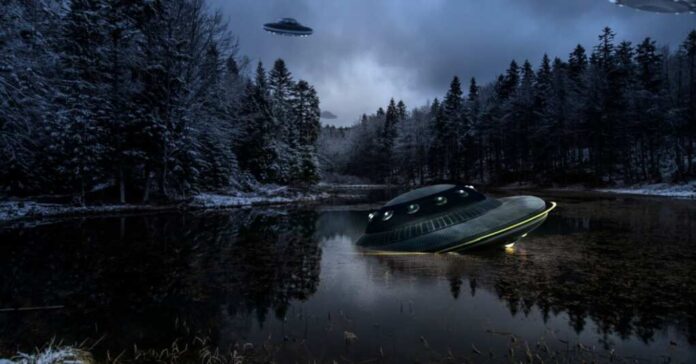
Is it possible that there’s a UFO sitting on the bottom of the Baltic Sea? There have been more and more discoveries that there may be alien life in our oceans…and that there are even underwater UFOs being recorded by the Navy…
In 2011, Swedish explorers Peter Lindberg and Denis Asberg made an astounding discovery while conducting a treasure-hunting expedition in the Baltic Sea. Their sonar equipment detected a massive circular structure nearly 300 feet below the water’s surface, measuring approximately 200 feet in diameter. What made this finding even more intriguing were the angular lines and stair-like formations on the structure, leading to comparisons with the iconic Millennium Falcon from Star Wars.
The news of this discovery quickly spread, sparking a wave of speculation and theories about the origin and nature of the object. Some suggested that it could be the remnants of an ancient civilization. In contrast, others proposed ideas ranging from a UFO shell to a hidden Nazi weapon or even an entrance to a secret World War II bunker.
One of the factors that added fuel to the speculative fire was diver Stefan Hogerborn’s claim that electrical equipment malfunctioned near the anomaly. This led to speculations that the structure might be made of metal, hinting at a potential extraterrestrial or mysterious origin. Geologist Steve Weiner’s tests initially supported this notion by indicating the presence of non-natural metals.
However, not all experts were convinced by these sensational claims. Geologist Volker Brüchert conducted analyses that pointed towards more mundane materials like granite and sandstone, suggesting a geological rather than an otherworldly explanation dating back to the Ice Age.
Despite the diverse opinions and theories, a consensus among scientists eventually leaned towards a natural cause for the anomaly. Many experts proposed that it formed due to glacial movements during the Ice Age, possibly involving sandstone, basalt from underwater volcanic activity, or a glacial moraine—deposited rocks and sediment.
Nevertheless, the mystery surrounding the Baltic Sea Anomaly continues to capture public interest. Peter Lindberg, one of the co-discoverers, remains fascinated by the object’s unique features, emphasizing that it serves as a reminder of the many mysteries still waiting to be unraveled beneath the ocean’s depths.
The ongoing debate about the Baltic Sea Anomaly highlights the complexity of scientific exploration and the allure of unexplained phenomena. While some enthusiasts continue to champion exotic explanations, such as ancient civilizations or alien artifacts, mainstream scientific inquiry leans towards natural geological processes.
In modern times, UFO mania has gripped the public imagination like never before. With the proliferation of social media, conspiracy theories, and sensationalist media coverage, reports of unidentified flying objects have become a staple of popular culture. From viral videos of strange lights in the sky to alleged encounters with extraterrestrial beings, the fascination with UFOs shows no signs of fading.
Project Blue Beam is one of the most enduring and controversial conspiracy theories about UFOs. This theory, which originated in the 1990s, states that the government—or a shadowy group within it—is allegedly planning to stage a false flag alien invasion or religious event using advanced holographic technology. The goal? To manipulate and control the masses through fear, advancing a global agenda of power and domination.
Supporters of the Project Blue Beam theory point to purported evidence, such as alleged leaked documents and whistleblowers, as proof of a covert government operation. They argue that the increasing prevalence of UFO sightings and the mainstreaming of extraterrestrial narratives serve as a precursor to the ultimate deception.
However, skeptics dismiss Project Blue Beam as a far-fetched conspiracy theory without credible evidence. They argue that orchestrating a large-scale hoax involving advanced technology and global coordination is logistically implausible and politically risky.
Despite the skepticism, Project Blue Beam thrives in the fringes of conspiracy culture, perpetuated by online forums, alternative media outlets, and self-proclaimed experts. For believers, it represents the ultimate cautionary tale about the power of deception and the need for vigilance in an era of information warfare.
In the age of UFO mania and digital disinformation, separating fact from fiction has never been more challenging. As the debate rages on, one thing remains clear. Whether fueled by genuine curiosity or deep-seated paranoia, humanity’s fascination with the unknown will continue to drive the search for answers in the cosmos.














